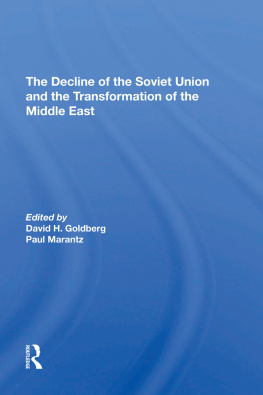First published 1985 by Westview Press
Published 2019 by Routledge
52 Vanderbilt Avenue, New York, NY 10017
2 Park Square, Milton Park, Abingdon, Oxon OX14 4RN
Routledge is an imprint of the Taylor & Francis Group, an informa business
Copyright 1985
Tel Aviv University
Jaffee Center for Strategic Studies
All rights reserved. No part of this book may be reprinted or reproduced or utilised in any form or by any electronic, mechanical, or other means, now known or hereafter invented, including photocopying and recording, or in any information storage or retrieval system, without permission in writing from the publishers.
Notice:
Product or corporate names may be trademarks or registered trademarks, and are used only for identification and explanation without intent to infringe.
LC 85-51351
ISBN 13: 978-0-367-29056-6 (hbk)
This study analyzes Soviet military engagement in Middle East wars in the post-1967 era. It clarifies the nature and characteristics of this engagement, offers an explanation for its occurrence and tries to predict future trends.
Soviet military engagement in Middle East wars consists of two major components: military involvement and military intervention. The term military involvement refers to all the kinds of military support rendered to local clients (e.g., arms shipments, advisory support), short of operations conducted by regular Soviet units. Military intervention, on the other hand, includes the wide spectrum of activities performed by Soviet regular units (naval, aerial, air-defense or ground) on behalf of the local client.
Two interconnected groups of factors determine the nature and exact pattern of Soviet military engagement in Middle East wars. The internal factors considered comprise Soviet military doctrine and Soviet power-projection capabilities. External factors involve the political and military nature of the war itself, as well as the level of superpower engagement in it.
The empirical record of Soviet military engagement in Middle East wars in the post-1967 era clearly indicates that Soviet behavior has been conservative rather than revolutionary; reactive and defensive rather than offensive and initiating; cautious and incremental rather than forceful and resolute. Thus, not only has the USSR not encouraged its Middle East clients to resort to arms in pursuit of their foreign policy goals, but it has often attempted to dissuade them from embarking upon a belligerent course. When its local clients nevertheless chose to initiate wars, the USSR always refrained from supporting them militarily unless they were driven back to the defense. Hence the Soviets have completely avoided any military engagement in offensive war operations, and/or war operations conducted outside their local clients territory. Even when the Soviets eventually became engaged in shoring up a local clients defensive posture, the engagement was defensive and incremental, and was designed to help the local client cut its losses and hold back the opposing party, rather than to enable it to move to the offensive.
Soviet military engagement in Middle East wars has been determined first and foremost by regional considerations, namely, the political and military nature of the war, rather than by global factors. Thus, not only has American engagement in Middle East wars not served to restrain Soviet engagement, but it has often had an escalatory impact on Soviet military conduct. The level of the USSRs engagement was dictated by its assessment of direct military costs on the one hand, and by consideration of its bilateral and multilateral political relations on the regional level, on the other. Nor, surprisingly, has close alignment with the Soviet Union ensured a higher level of support. On the contrary, in wars between a Soviet ally and a non-aligned state or, alternatively, between two Soviet allies, the USSR chose to support the non-aligned or less closely aligned country.
Taking past Soviet conduct in Middle East wars into account, this study concludes that in a future Arab-Israeli war, should the need arise:
- Arms will be supplied to the local client;
- Advice and guidance by a Soviet advisory mission deployed in the local army will be given (with the exception perhaps of participation in front-line fighting);
- Demonstrative activities of the Mediterranean Squadron on behalf of the Arab war effort will be performed;
- Air-Defense, EW, and perhaps even aerial units may be dispatched to the battle-zone if needed.
Direct ground intervention, the only mode of Soviet military engagement not performed to date, is most unlikely. It is assumed that this type of intervention might take place in an extreme situation when the regime of the local client faces imminent danger. However, under no circumstances will the USSR go beyond the dispatch of a token force, designed to perform deterrent functions i.e., to delineate the limits to an Israeli advance.
Despite a significant growth in the scope and intensity of Soviet military engagement in Middle East wars since the late sixties, few research studies have focused specifically upon this subject. The bulk of the extensive literature on Soviet Middle East policies including most studies on the military aspects of these policies generally maintains a political outlook, with the military role occupying a secondary role.
This study seeks to bridge this specific gap in the study of Soviet Middle East policies. Its aim is to construct an analytical framework of Soviet military engagement in Middle East wars on behalf of a local client. The purpose of the framework is to clarify the nature and characteristics of this engagement, offer an explanation for its occurrence and serve as a basis for predicting future trends.
Two definitions serve as a focus for the discussion and delineate its boundaries. First, for purposes of this study, the term war refers to a contention between two or more states through their armed forces,.)
The delineation of the studys subject matter may be further clarified by listing types of international interactions excluded by the above definitions:
1. Soviet military engagement in interstate conflictual situations short of war (such as an interstate crisis);
2. Soviet military engagement in civil wars, with the exception of internationalized civil wars namely, civil wars involving external participation of local third parties (e.g., the Syrian intervention in Lebanon in 1976);
3. Soviet armed aggression against Third World countries performed in pursuit of self-extension goals, and not on behalf of a belligerent Third World client (such as the invasion of Afghanistan);
4. Non-military engagement (political, economic) and indirect forms of penetration (subversion, covert activities, etc.);
5. Statements about Soviet military power and threats of armed intervention, unless accompanied by a discrete military operation taken on behalf of the local client.
The study consists of four chapters. The first two are theoretical: they present the analytical framework, describe and define its component elements, and determine their operational values. Two interconnected groups of factors determine the nature and exact pattern of Soviet military engagement in Middle East wars:
- Soviet military doctrine
- Soviet power-projection capabilities
- Political nature of the war














